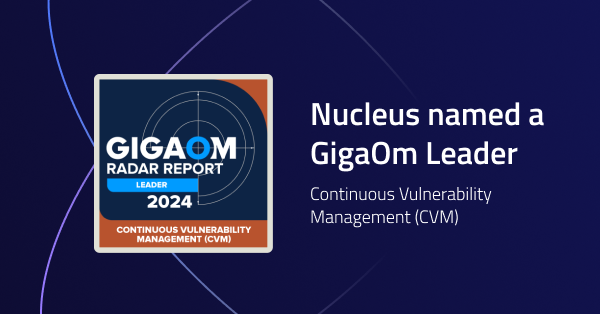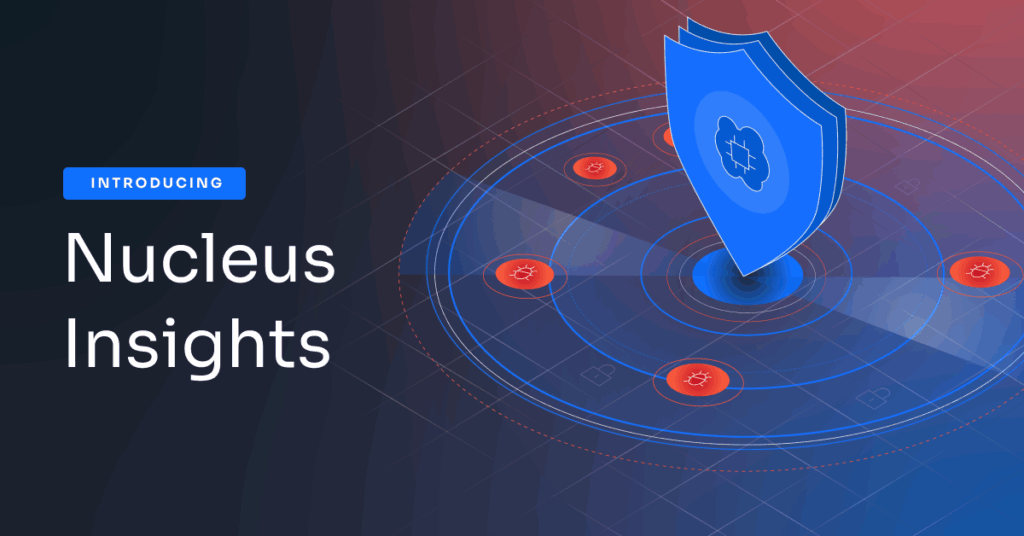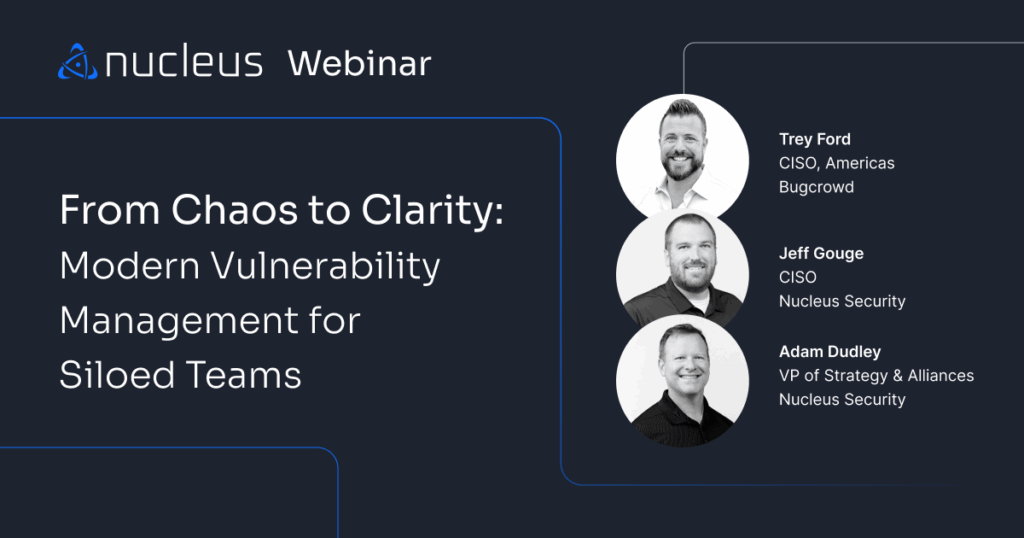5 Things Holding Back Your Vulnerability Management Program and How to Overcome Them Step by Step
Webinar Summary
Vulnerability management teams face significant challenges, both internal and external, while building their VM program.
Manual processes, tools that don’t integrate or duplicate results, and ineffective workflows are just a few challenges that limit VM teams’ ability to build a modern VM program.
In this webinar, cybersecurity experts Scott Kuffer, COO, Nucleus Security, and Gene Bandy, Information Security Manager, R1 RCM, will discuss the top 5 things holding back your vulnerability management program, and offer a practical implementation blueprint towards modern automation.
Join as they discuss five challenges in VM, including:
- Too many labor-intensive processes, even though security teams use many automated tools.
- Lack of coverage and low assessment frequency. At the current ‘speed of cyber’ quarterly and monthly scans are not enough.
- Too many scanning tools. New security tools, overlapping coverage, and proprietary risk scoring result in chaotic alert overwhelm.
- Limited CVSS-based prioritization. Lack of organizational or threat context needed to identify actual risks.
- Ineffective ticketing workflows. Whether in PDFs, emails or tickets, security teams’ alerts are often ignored by their dev counterparts.
Key Takeaways
- Vulnerability management is a labor-intensive process that requires continuous effort and attention to detail.
- Ticketing workflows can be ineffective and lead to inefficiencies and delays in remediation.
- Prioritization is crucial in vulnerability management, and organizations need to find a balance between risk and resources.
- Scan coverage is a challenge for many organizations, and finding the right scanning cadence and tools is essential.
- Having too many scanning tools can lead to complexity and inefficiency, while consolidating tools can streamline the process.
Labor-Intensive Processes in Vulnerability Management
One of the primary challenges in vulnerability management is the labor-intensive nature of the process. Gene emphasizes the importance of continuous effort and vigilance in vulnerability management. He highlights the need for organizations to be proactive in identifying and fixing vulnerabilities to avoid being caught off guard and ending up in the news.Scott adds that vulnerability management involves numerous processes and tasks, making it a demanding and time-consuming endeavor. From asset management to tracking and maintaining vulnerabilities, the process requires constant attention and meticulousness.
Ineffectiveness of Ticketing Workflows
Ticketing workflows are another area where organizations often struggle in vulnerability management. Scott points out that the traditional process of creating tickets for vulnerabilities can be inefficient and lead to delays in remediation. He describes how vulnerabilities are often several steps removed from the original finding, making it challenging to track and validate actions.
Gene agrees, highlighting the importance of effective ticketing workflows in vulnerability management. He emphasizes the need for automation in this area to streamline the process and improve efficiency. By automating asset normalization and vulnerability ownership tracking, organizations can eliminate manual work and improve visibility.
Prioritization Challenges in Vulnerability Management
Prioritization is a critical aspect of vulnerability management, and organizations often struggle to find the right balance between risk and resources. Gene emphasizes the need for a risk-based approach, where vulnerabilities are categorized based on their potential impact and the criticality of the assets they affect. By prioritizing vulnerabilities based on their risk level, organizations can focus their resources on fixing the most critical issues first.
Scott introduces the concept of precision-based prioritization versus efficiency-based prioritization. He explains that traditional prioritization tools, such as CVSS and risk scores, focus on individual vulnerabilities rather than outcomes and ROI. He suggests that organizations should consider the broader implications and potential impacts of vulnerabilities when prioritizing their remediation efforts.
Scan Coverage Challenges and Solutions
Scan coverage is another area where organizations face challenges in vulnerability management. Gene emphasizes the importance of continuous scanning, particularly for external attack surfaces. He highlights the need to be proactive in scanning and patching vulnerabilities to stay ahead of potential threats.
Scott discusses the reasons behind the lack of scan coverage and suggests two possible solutions. One approach is to consolidate scanning tools and vendors to simplify the process and reduce administrative overhead. This approach allows organizations to leverage the capabilities of a single vendor and potentially receive better service and support.
The other approach is to use a tight integration layer to connect multiple best-of-breed scanning tools. While this approach offers the benefits
Closing Thoughts
Scaling vulnerability management is a complex task that requires organizations to address various challenges. From labor-intensive processes to ineffective ticketing workflows and prioritization difficulties, vulnerability management requires careful planning and execution. By understanding the root causes of these challenges and implementing effective solutions, organizations can improve their vulnerability management processes and enhance their overall security posture.
To help you with a step-by-step approach to solving some of these challenges, we’ve made a playbook for you to follow:
Achieving Comprehensive Coverage and High-Frequency Assessments
- Step 1: Comprehensive Asset Inventory
- Create and maintain an up-to-date inventory of all IT assets, including hardware, software, and cloud resources.
- Step 2: Increase Assessment Frequency
- Schedule frequent and regular vulnerability scans (e.g., weekly or bi-weekly) across all assets.
- Implement continuous monitoring solutions for real-time vulnerability detection.
- Step 3: Ensure Full Coverage
- Use scanning tools that cover a wide range of vulnerabilities, including software, hardware, and configuration issues.
- Perform regular gap analyses to identify and address areas of incomplete coverage.
- Step 4: Review and Adjust
- Regularly review scan results and coverage reports to ensure all assets are being assessed.
- Adjust scanning schedules and tools as necessary to cover any missed areas.
Streamlining Labor-Intensive VM Processes
- Step 1: Identify Labor-Intensive Processes
- List out all VM processes and identify which ones are the most time-consuming and repetitive.
- Step 2: Implement Automation Tools
- Deploy automated vulnerability scanning tools to run scheduled scans.
- Use automated reporting tools to generate vulnerability reports.
- Implement patch management solutions that automate patch deployment.
- Step 3: Integrate and Orchestrate
- Integrate VM tools with SIEM, ticketing systems, and other security platforms.
- Use orchestration tools to automate workflows, ensuring smooth data flow and task management.
- Step 4: Continuous Improvement
- Regularly review automated processes to identify areas for further optimization.
- Gather feedback from the team and refine automation strategies as needed.
Consolidating and Optimizing Scanning Tools
- Step 1: Assess Current Tools
- Inventory all scanning tools currently in use and evaluate their effectiveness and overlap.
- Step 2: Consolidate Tools
- Select a core set of comprehensive scanning tools that cover all necessary vulnerability types and reduce redundancy.
- Retire or phase out less effective or redundant tools.
- Step 3: Integrate Chosen Tools
- Ensure that the selected tools are integrated into a unified vulnerability management platform.
- Implement centralized dashboards for consolidated reporting and analysis.
- Step 4: Optimize Processes
- Streamline scanning processes to ensure efficient use of the selected tools.
- Regularly review tool performance and make adjustments as needed.
Enhancing Vulnerability Prioritization Beyond CVSS
- Step 1: Expand Prioritization Criteria
- Develop a multi-factor risk assessment model that includes CVSS scores, asset criticality, exploitability, and business impact.
- Step 2: Integrate Threat Intelligence
- Use threat intelligence feeds to identify which vulnerabilities are actively being exploited in the wild.
- Step 3: Implement Risk-Based Tools
- Utilize tools that automate risk-based prioritization by considering additional contextual factors beyond CVSS.
- Step 4: Regular Reassessment
- Continuously monitor and reassess vulnerabilities as new information becomes available.
- Update prioritization criteria to reflect the evolving threat landscape and business needs.
Optimizing Ticketing Workflows for Efficient Vulnerability Remediation
- Step 1: Review and Redesign Workflows
- Map out current ticketing workflows and identify bottlenecks and inefficiencies.
- Step 2: Define Clear Roles and Responsibilities
- Establish clear ownership and accountability for each stage of the vulnerability remediation process.
- Step 3: Automate Ticketing
- Integrate vulnerability management tools with ticketing systems to automate ticket creation, assignment, and tracking.
- Use automated notifications and reminders to ensure timely remediation.
- Step 4: Improve Communication and Collaboration
- Enhance communication channels between teams involved in remediation.
- Conduct regular meetings to discuss progress, challenges, and solutions.
- Step 5: Monitor and Optimize
- Use metrics and KPIs to track the efficiency of ticketing workflows.
- Regularly review and optimize workflows based on feedback and performance data.
Building Effective VM Teams
- Step 1: Assess Team Needs
- Identify the specific skills and expertise required for an effective VM program.
- Step 2: Strategic Hiring
- Hire professionals with a mix of technical skills, strategic thinking, and communication abilities.
- Step 3: Invest in Training and Development
- Provide continuous training opportunities to keep team members up-to-date with the latest tools, techniques, and threat landscapes.
- Step 4: Foster Collaboration and Cross-Training
- Promote collaboration between VM teams and other IT and security teams.
- Implement cross-training programs to build a versatile and resilient team.
- Step 5: Create a Positive Work Environment
- Recognize and reward contributions to maintain high morale and reduce turnover.
- Ensure a healthy work-life balance and provide opportunities for career growth.
- Step 6: Leverage External Expertise
- Partner with external organizations and communities for threat intelligence and specialized training.
See Nucleus in Action
Discover how unified, risk-based automation can transform your vulnerability management.































